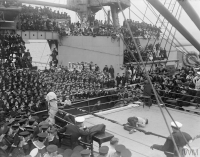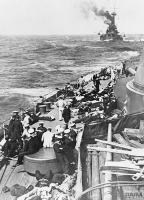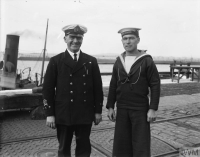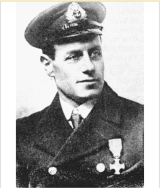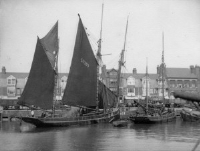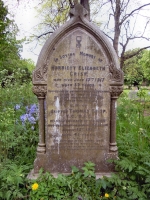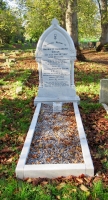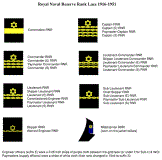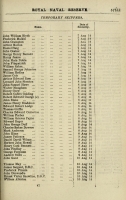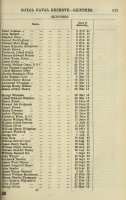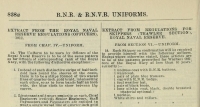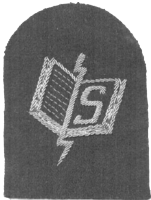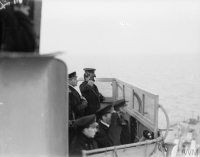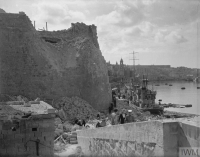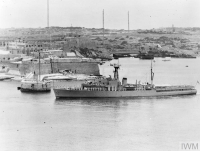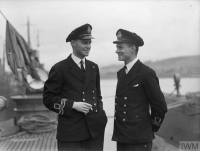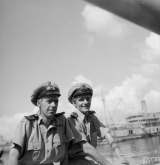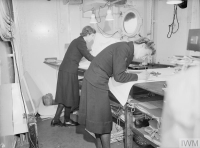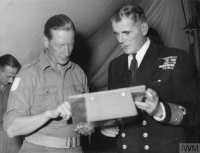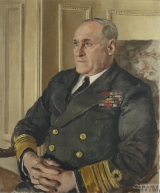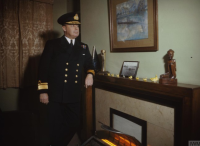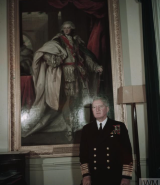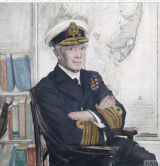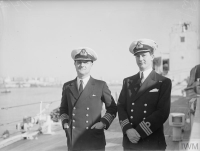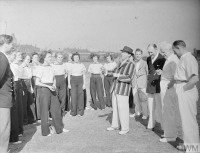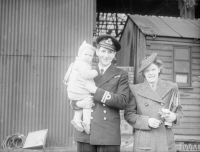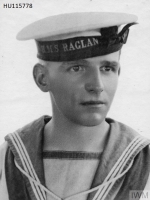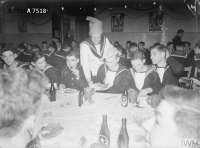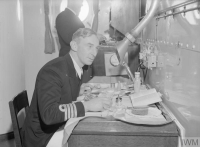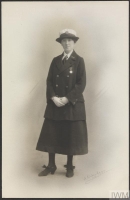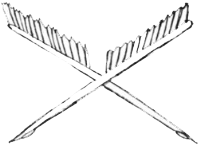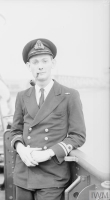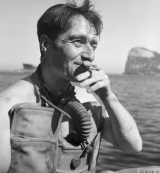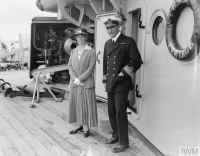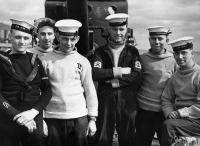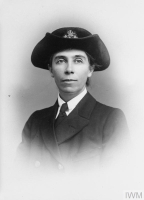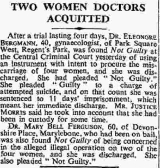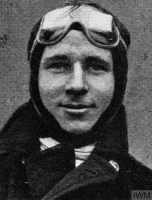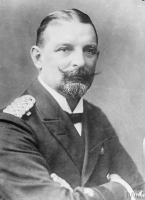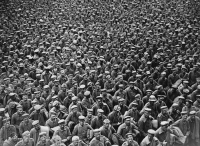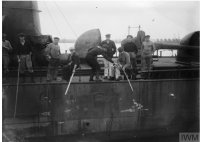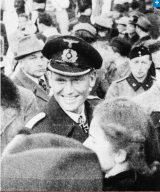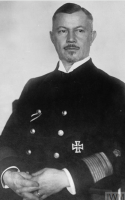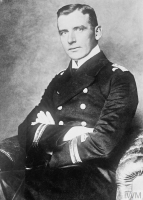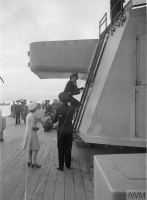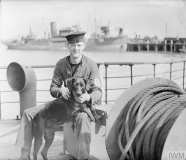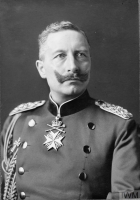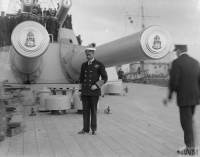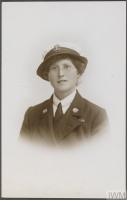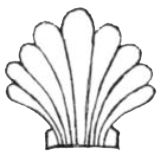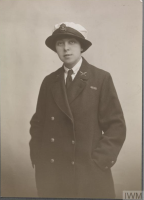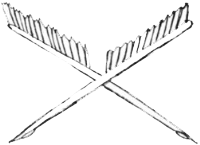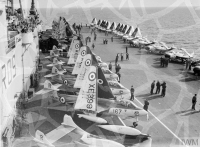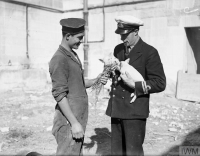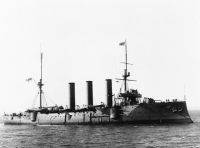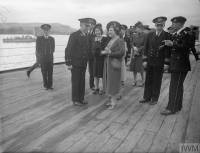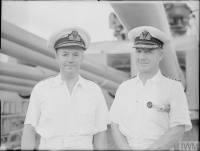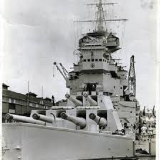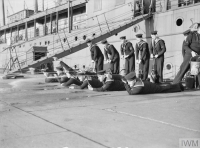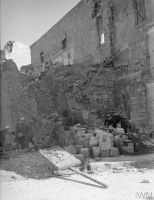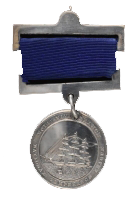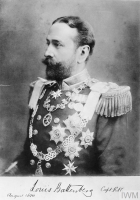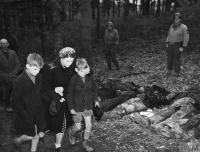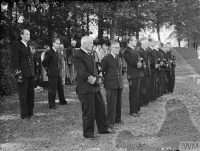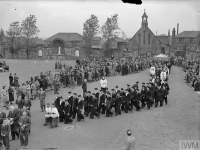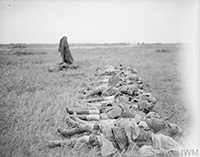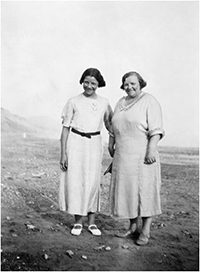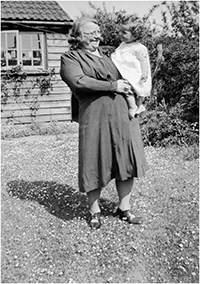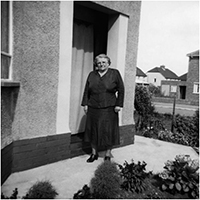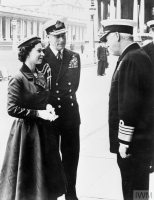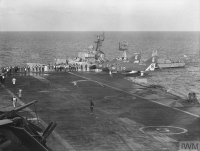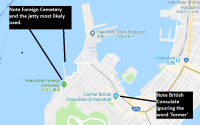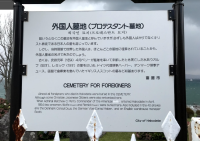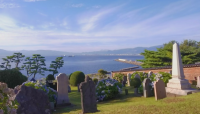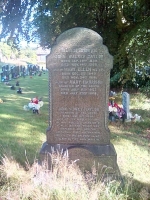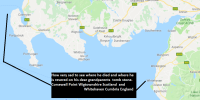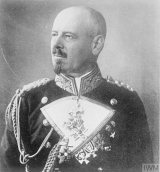
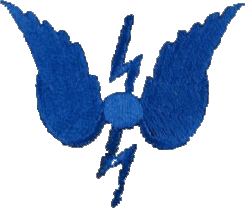

A Few Naval Photographs of Interest
Courtesy of the Imperial War Museum who own the copywright to all images on this page
Written by Godfrey Dykes© RN Communications Branch Museum/Library
<
(By Webmaster: All images are thumbnails which can be enlarged by clicking on them. When you click on a thumbnail it will be necessary to click on the back button on your browser to return to the main page - this will ensure that you see the original image in full size.)
Accompanying text is the result of my research or added by me to the IWM photograph where ambiguity could arise, or is insufficient to fully describe or explain the nature of the IWM photograph. Despite the good and well intended text added by IWM employees, there are some errors although no comments on any typos!
The ceremonial unveiling of the Guards Memorial on the St James' Park side (west side of Horse Guards Parade) central London. The text on the IWM site associated with this picture runs entirely contrary to that of other records of the event, so here is what appears to have happened. Before we do that, it is only fair to say that this IWM page shows the Memorial in a much better light and should be visited to achieve a fair balance IWM Memorial
The event took place on Saturday the 16th October 1926, unveiled by HRH Prince Arthur the 3rd son of Queen Victoria and brother of Edward VII, who was a Field Marshall in the British Army during WW1: Princess Elizabeth was just a few months old being born in April 1926. This is a quote from Wikipedia's site on the subject matter. The Prince "accompanied by the 100-year-old veteran of the Crimean War General Sir George Higginson, with a dedication by Rev. H. J. Fleming, who became senior chaplain of the Guards Division when it was formed in 1915, and a benediction by the Chaplain-General to the Forces, Rev. Alfred Jarvis, and a march-past by 15,000 serving and former guardsmen. The memorial suffered bomb damage in the Second World War, and some was left unrepaired as "honourable scars."
As one can see from the picture on the right, Beefeaters also attended the ceremony as did many members of the Royal Family including the Prince of Wales. At the unveiling the two union flags, one covering the front and one the back of the Memorial collapsed to reveal the beautiful shrine.
Most of us will know about the Victoria Cross and that it was made from the bronze in melted down Chinese guns at least from 1914, and not, as originally thought, from Russia guns engaged in the Crimean War in the mid-19th century. Here is another case of melted down enemy guns to salvage the bronze element, for the bronze name plates on the Guards Memorial come from German captured guns in WW1.
This very small page also should be read, especially the note on an old post card at the bottom Guards Memorial Horse Guards Parade
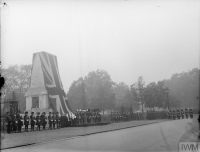
The ceremonial unveiling of the Guards Memorial
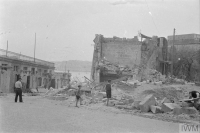
Lonely Malta
1942. Lonely Malta the most bombed heavily populated small island in the world, then and since.
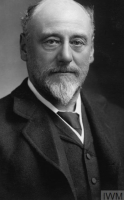
Admiral of the Fleet Sir Frederick Laurence Field
Admiral of the Fleet Sir Frederick Laurence Field, GCB, KCMG born to English parents serving with the army in Ireland.
Served from 1884 until 1933, qualifying as a torpedo specialist. He was involved in the Boxer Uprisings in China in 1900 and in WW1 he was the CO of the battleship HMS King George V engaged at Jutland as the flagship of Admiral Martyn Jerram who Beatty publicly criticised for not supporting him as darkness fell - Admiral Jerram retired in 1917. Admiral Field was applauded for the great skill shown when handling the KG V under great difficulties. He went to be the C-in-C Mediterranean and then the First Sea Lord. He had a very active career with much time spend at sea in capital ships (battlecruisers and battleships). For his services he was awarded many foreign high honours. Promoted to rear Admiral almost immediately after the end of WW1. He is famously known for his command of the Empire Cruise flying his flag in the Hood, which lasted for 308 days. I show pictures of that cruise on my web page HMS Hood World Cruise. He more than ably handled the Invergordon mutiny of September 1931, forcing the Admiralty Board to a rethink on the severity of the proposed cuts in pay. He encouraged the banning of the 10 year rule in which planning and defence spending were geared to what a committee thought would happen in the next ten years before increasing navy estimated. Quite often they decided peace would prevail, often getting it badly wrong. He died of cancer at the end of WW2 at his home in North Yorkshire. He was 74.
Milton Thomas, Able Seaman, kia in WW1 26 Oct 1917 RNVR RND Howe Battalion
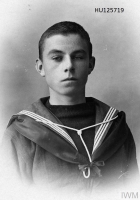
Milton Thomas

Captain MacLachlan
Captain MacLachlan inspecting divisions of the quarter deck of the battleship HMS Royal Oak. Note her secondary weapons (5"?) top right trained on the beam.
Engineer Commander S A MacGregor OBE R.N. Flotilla Engineering Officer Malta.
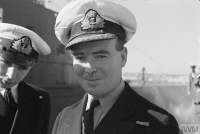
Engineer Commander S A MacGregor
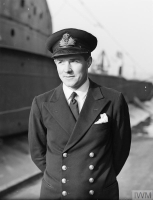
Lieutenant A J W Pitt
Lieutenant A J W Pitt, RN, Commander of HM Submarine TAKU, from 10th October '42 to 7th May 1944
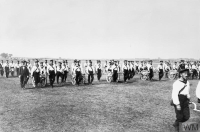
German naval machine guns
German naval machine guns unit parading for the Kaisers visit in 1904.
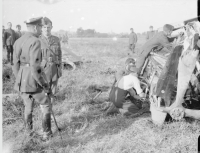
H.M. King George V
WW1. H.M. King George V in France at Cassel, a town in northern France overlooking Flanders France, looking over to a crashed aircraft with a very bent and broken propeller.
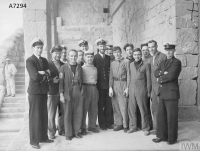
Lieutenant Commander Malcolm David Wanklyn
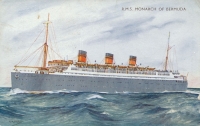
SS Monarch
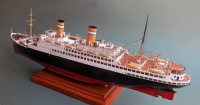
SS conte Rosso
The iconic Lieutenant Commander Malcolm David WANKLYN VC, DSO and Two Bars centre, a very famous WW2 submarine ace, hero with his crew of HM Submarine UPHOLDER at their Mediterranean base LAZARRETO, Manoel Island, Marsamxett Harbour, Malta.British U-Class and S-Class were tiny cramped submarines, and I remember as a naval boy on my first ship HMS Tintagel Castle at Portland, going onto the resident submarine depot ship at Portland, HMS Maidstone in 1955, mother-ship to the Second submarine flotilla (U and S class boats), and having an acquaint in HM submarine Upstart. Within a couple of months of having that experience, HM submarine Sidon blew up alongside the Maidstone leading to the deaths of thirteen men.The accolade of being possibly the most successful submarine captains of the allies resonated throughout all allied navies, and although grudgingly was acknowledged by the enemy submarine navies as being the master of the kill. He sank 16 enemy ships. He served his country from 1925 until 1942, and in that year he and his famous submarine was reported as missing, soon to be known as lost (14th April), which he had joined on the 8th August 1940 after two extremely brief periods in submarines Otway and H32. This incomparable submarine captain was just 30 years of age.The ace submariner won his Victoria Cross for the sinking of the Italian Liner 'Conte Rosso' in 1941. She was indeed a civilian liner but on this occasion she was packed to the gunnels with Italian troops and their equipment heading south to North Africa to join up with German forces fighting our Desert Rats, and she was escorted by many destroyers to make sure she made a safe and satisfactory land fall. The troopship sank and Upholder then endured a strong counter-attack in which 37 depth charges were dropped in 20 minutes, before she got clear. By the end of 1941 Lieutenant-Commander Wanklyn had sunk nearly 140,000 tons of enemy shipping. It is estimated that 1300 people perished but the Italian story was cloaked in mystery albeit they admitted that the civilian liner was a troop ship and therefore an enemy combatant eligible and likely to be attacked and sunk. Seemingly some researchers in Axis shipping data claim (on line) that the troopship had a crew of 280 and with 2449 troops some of whom may have been Germans. Italian pre war printed data shows the Conte Rosso as having 208 first class berths, 268 second class and 1890 third class berths. We know that the troopship, a relatively small vessel when compared with ocean going world luxury liners, was off Sicily and the wreck site is well documented.
Loss of Submarine The Citation in the London Gazette of 16th December, 1944, gives the following details:On 24th May, 1941, while off the coast of Sicily, Lieutenant-Commander Wanklyn, in command of H.M. Submarine Upholder, sighted an enemy troop convoy escorted by destroyers. Observation by periscope could not be relied on, owing to failing light, and a surface attack would have been easily seen. Upholder's listening gear was out of action. Despite these difficulties, Lieutenant-Commander Wanklyn, though aware of the risk of being rammed by the escorting destroyers, pressed home his attack and sank a large troopship. The destroyers at once counter-attacked, and dropped thirty-seven depth-charges. With great courage, coolness and skill, and without listening gear, Lieutenant-Commander Wanklyn brought Upholder clear and back to harbour. Before this outstanding attack and since being made a Companion of the Distinguished Service Order, Lieutenant-Commander Wanklyn had torpedoed a tanker and a merchant vessel. He continued to show the utmost courage in the face of the enemy, and carried out attacks on enemy vessels with skill and relentless determination, sinking one destroyer, one U-boat, two troop transports, one tanker and three supply ships. He also probably destroyed, by torpedoes, one cruiser and one destroyer, and probably hit another cruiser.
Wanklyn Malcolm David CWGC Commemorative
The Italian Liner SS Conte Rosso had an important part to play in diplomatic exchanges at the beginning of WW2 known as the phoney war in 1940. Obviously the British Embassy had to move back to London from Rome and the Italian Embassy had to move back to Rome from London. This was part accomplished by the Italian Liner and part by a British vessel sailing from Glasgow to, so-called *neutral Portugal, to Lisbon, called the 'Monarch of Bermuda'. At all times she had to steer a zig-zag course and be on the lookout for sea- mines, the Luftwaffe and the Kreigsmarine both surface and sub surface German vessels. The Monarch of Bermuda by this time had been taken over by the British Admiralty acting as a troop ship whilst at the same time the 'Queen of Bermuda' had been armed and was acting as an armed cruiser.
The Italian's trapped in Britain at the declaration of Italy's war which was much later than Germanys declaration, were either interned in the UK (most on the Isle of Man as friendly and released before Italy surrendered in 1943) or elected to be deported to Italy to assist its war aspirations, or to be deported to other countries other than Italy for the duration. Great numbers were drowned when their ship Andorra Star was sunk by U-Boat off Malin Head north of Ireland whilst making for Halifax Canada. *Portugal our oldest ally, was, along with Sweden, Colombia and Switzerland officially a neutral but assisted the Allies, whilst Spain, also neutral assisted the Axis Powers.
Mass burial at a cemetery in the tropics.

Mass burial at a cemetery in the tropics.
Chief Wren Telegraphist WRNS. WW2 in Ceylon.
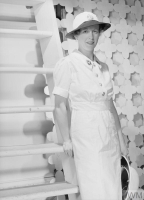
CWRN Telegraphist
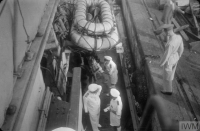
Lady Shirley alongside jetty

Lady Philomena a Hull Lady Class fishing trawler
David and Goliath
In September 1941 whilst heading for the UK in a convoy S.S. Silverbelle was torpedoed and damage in the South Atlantic by UBoat U68. She and other UBoats searched for her after the action. In October '41 U111 at periscope depth whilst approaching Tenerife from the south, sighted what she thought was the damaged Silverbelle still afloat and with precious war cargo from Durban South Africa on board. She approached cautiously ready to torpedo the surfaced vessel. What she was approaching was a small R.N. requisitioned Hull Trawler also looking out for the Silverbelle, packed full to the brim with anti submarine detection equipment (ASDICS) and weapons, depth charges, plus a volatile 4" gun. The trawler was called HMS Lady Shirley (or just H.M.T. Lady Shirley, and her R.A.N. Lieutenant Commander CO, RAN Volunteer Navy, Arthur Henry CALLAWAY DSO, had good lookout's spotting the periscope wake at some distance, immediately attacked the dived submarine with depth charges. This brought the rather large submarine to the surface when the attack resumed with heavy machine guns and for really good measure at close range 4" shells shredding the upper deck and conning tower and rupturing her ballast tanks. The crew immediately abandoned the submarine jumping into the sea and shortly afterwards sunk in very deep water. Of the crew of 55, 44 were saved and taken to the trawler's base Gibraltar as POW's. The UBoat captain was one of the missing crew members. The event was rightly marvelled at, but it was also the very first time prisoners had been captured from a submarine at sea on war patrol.
The 2nd picture shows the Lady Shirley alongside a jetty being visited by very senior officers in great congratulatory mood for such a Herculean task. One crew member died and a couple more from a crew of 33 were injured. She was a much feted vessel especially in the western Mediterranean.
In the absence of a suitable Lady Shirley picture, the 2nd photo is a Hull Lady Class fishing trawler, the Lady Philomena.
Start of Bismarck's and Tirpitz's very short operational lives measured in just a few weeks only
In this short piece of film Bismarck is seen sailing from the Baltic port of Gdynia Poland (with the heavy cruiser Prinz Eugen following on astern as a distance) at the start of Bismarcks short life of just a few weeks only. The Bismarck sails on the 18th May 1941. Apologies for the chopped off end matching Hitler's sorrow I'll wager! Note that from stem to X turret on the quarterdeck, members of the ships company languish on the upper deck and many of the decks within the superstructure, but as we get deeper onto the quarterdeck we see sailors dressed in their finery cheering ship, saluting those on the canal bank in a final farewell, by raising their caps in the air. If only they knew their oncoming fate??.
Her sister TIRPITZ also had a very short operational life, spending virtually four years hemmed up in a Norwegian Fjord defending herself from constant British naval and air force attacks, not doing what she was designed to do. She joined the Kreigsmarine a few weeks before her smaller sister (by 2000 tons) Bismarck was destroyed in the Atlantic principally by the British battleships 'King George V' and the Rodney' supported by a whole host of warships. Their joint destructions with so precious little return of service, crippled the morale of the Kreigsmarine surface fleet and the Nazi regime as well as the German people as a whole, who profoundly believed that these two ships would destroy the Royal Navy and therefore win the war. For all intents and purposes, the British (RN and RAF) destroyed the might of the German surface fleet, also playing the major role in destroying the German UBoat fleet.
At St Nazaire, a port in NW France in the Bay of Biscay near the City of Nantes, was a super sized sea dock to accommodate the size of these two vessels, and it was the perfect home base port area (Brest plus St Nazaire) for ships out raiding merchant ship convoys crossing the Atlantic from West to East bringing vital war supplies from Canada and the USA to Britain. Shutting down this facility would severely hamper their destruction of the convoys. At the time of Bismarck's destruction she was heading for Brest (a port a little further North up the the French coast from St Nazaire) to have repairs carried out inflicted upon her with her interchanges with the Hood some days before. Had the damage been more serious she could well have docked at St Nazaire. It was still fully serviceable after the loss of Bismarck (27th May 1941) for use by the Tirpitz. Churchill ordered it to be destroyed in March 1942 which the Royal Navy did and in great style, but sadly with many brave men dying in the process not to mention a multitude of Germans!
This forced Tirpitz to seek sanctuary elsewhere and the only place available and to still allow it access to the Atlantic was a Norwegian Fjord. It was barren country for the needs of the ship and of the crew whose morale tumbled. As late as early Spring 1944, when the Tirpitz could still technically force its way into the Norwegian Sea and then into the Atlantic or North Sea (but never did), and the plans were being finalised for the Normandy landings in June 1944, there was a fear that the Tirpitz could create merry hell in the Channel totally disrupting the landings. Tirpitz had to go, and attempts to sink her, time after time failed. It was then that we sought the wizardry of a hero scientist, one Dr Barnes Wallis, he of the bouncing bomb fame, which wrecked the dams of the German Ruhr, disrupting their war manufacturing ability. He designed the most powerful bomb every known to man at that time (12,000 lbs) and non-nuclear, which he called a TALL BOY, and trusted it with the RAF Squadron, 617, known as the Dam Busters, to deliver it in almost in/on impossible navigational terrain which had to be dropped from 15 to 20 thousand feet, no lower which of course made bomb aiming that much more difficult. Barnes Wallis and 617 Squadron, as far as the general public were concerned, were one and the same. 617 took off with 20+ Lancaster bombers. each one carrying a single Tall Boy, with at least three scoring direct hits killing well over 1000 men and leaving the Tirpitz turtle-fashion, good and for all time dead. However that was not until November 1944 by which time the Normandy landing troops were well on their way to the German border, ready for an all out assault and heavy punishment on a wicked nation!
By May 1945 all Germany's surface fleet units with the except of a handful of destroyers had been utterly destroyed and put out of action - compare that with the sheer amounts of UBoats that surrendered intact and were destroyed by us in the years that followed VE day. Only one big surface vessel was taken as a floating but totally incapacitated vessel and that was the heavy cruiser Prinz Eugen (remember her being with the Bismarck shortly before its destruction in May 1941) which was dragged off to the Pacific to be used in atomic bomb tests and trials of the 1950's. Her end was as ignominious as all other German ships, which finished WW2 as they did WW1, more than ably demonstrating that they were no match for the British, either our illustrious navy and mercantile fleet, or for our air force, then or any time in the future!
By visual comparison why not have a look at my web page called The Navy and its Changes during my 30 year career. Note the COLOUR CODING and that in the 1950's in my time of joining we had FIVE coloured RED = Battleships for openers. We finished WW2 with over 600 vessels having a name with the prefix H.M.S., this discounting ships like Depot Ships, very small vessels, hospital ships/Royal Yacht vessels, transport ships, replenishment ships and many other types.
See also Hood World Cruise photos
(By Webmaster: All images are thumbnails which can be enlarged by clicking on them. When you click on a thumbnail it will be necessary to click on the back button on your browser to return to the main page - this will ensure that you see the original image in full size.)
Accompanying text is the result of my research or added by me to the IWM photograph where ambiguity could arise, or is insufficient to fully describe or explain the nature of the IWM photograph. Despite the good and well intended text added by IWM employees, there are some errors although no comments on any typos!
The ceremonial unveiling of the Guards Memorial on the St James' Park side (west side of Horse Guards Parade) central London. The text on the IWM site associated with this picture runs entirely contrary to that of other records of the event, so here is what appears to have happened. Before we do that, it is only fair to say that this IWM page shows the Memorial in a much better light and should be visited to achieve a fair balance IWM MemorialThe event took place on Saturday the 16th October 1926, unveiled by HRH Prince Arthur the 3rd son of Queen Victoria and brother of Edward VII, who was a Field Marshall in the British Army during WW1: Princess Elizabeth was just a few months old being born in April 1926. This is a quote from Wikipedia's site on the subject matter. The Prince "accompanied by the 100-year-old veteran of the Crimean War General Sir George Higginson, with a dedication by Rev. H. J. Fleming, who became senior chaplain of the Guards Division when it was formed in 1915, and a benediction by the Chaplain-General to the Forces, Rev. Alfred Jarvis, and a march-past by 15,000 serving and former guardsmen. The memorial suffered bomb damage in the Second World War, and some was left unrepaired as "honourable scars."As one can see from the picture on the right, Beefeaters also attended the ceremony as did many members of the Royal Family including the Prince of Wales. At the unveiling the two union flags, one covering the front and one the back of the Memorial collapsed to reveal the beautiful shrine.Most of us will know about the Victoria Cross and that it was made from the bronze in melted down Chinese guns at least from 1914, and not, as originally thought, from Russia guns engaged in the Crimean War in the mid-19th century. Here is another case of melted down enemy guns to salvage the bronze element, for the bronze name plates on the Guards Memorial come from German captured guns in WW1.This very small page also should be read, especially the note on an old post card at the bottom Guards Memorial Horse Guards Parade |  The ceremonial unveiling of the Guards Memorial |
 Lonely Malta | 1942. Lonely Malta the most bombed heavily populated small island in the world, then and since. |
 Admiral of the Fleet Sir Frederick Laurence Field | Admiral of the Fleet Sir Frederick Laurence Field, GCB, KCMG born to English parents serving with the army in Ireland.Served from 1884 until 1933, qualifying as a torpedo specialist. He was involved in the Boxer Uprisings in China in 1900 and in WW1 he was the CO of the battleship HMS King George V engaged at Jutland as the flagship of Admiral Martyn Jerram who Beatty publicly criticised for not supporting him as darkness fell - Admiral Jerram retired in 1917. Admiral Field was applauded for the great skill shown when handling the KG V under great difficulties. He went to be the C-in-C Mediterranean and then the First Sea Lord. He had a very active career with much time spend at sea in capital ships (battlecruisers and battleships). For his services he was awarded many foreign high honours. Promoted to rear Admiral almost immediately after the end of WW1. He is famously known for his command of the Empire Cruise flying his flag in the Hood, which lasted for 308 days. I show pictures of that cruise on my web page HMS Hood World Cruise. He more than ably handled the Invergordon mutiny of September 1931, forcing the Admiralty Board to a rethink on the severity of the proposed cuts in pay. He encouraged the banning of the 10 year rule in which planning and defence spending were geared to what a committee thought would happen in the next ten years before increasing navy estimated. Quite often they decided peace would prevail, often getting it badly wrong. He died of cancer at the end of WW2 at his home in North Yorkshire. He was 74. |
Milton Thomas, Able Seaman, kia in WW1 26 Oct 1917 RNVR RND Howe Battalion |  Milton Thomas |
 Captain MacLachlan | Captain MacLachlan inspecting divisions of the quarter deck of the battleship HMS Royal Oak. Note her secondary weapons (5"?) top right trained on the beam. |
Engineer Commander S A MacGregor OBE R.N. Flotilla Engineering Officer Malta. |  Engineer Commander S A MacGregor |
 Lieutenant A J W Pitt | Lieutenant A J W Pitt, RN, Commander of HM Submarine TAKU, from 10th October '42 to 7th May 1944 |
 German naval machine guns | German naval machine guns unit parading for the Kaisers visit in 1904. |
 H.M. King George V | WW1. H.M. King George V in France at Cassel, a town in northern France overlooking Flanders France, looking over to a crashed aircraft with a very bent and broken propeller. |
 Lieutenant Commander Malcolm David Wanklyn
| The iconic Lieutenant Commander Malcolm David WANKLYN VC, DSO and Two Bars centre, a very famous WW2 submarine ace, hero with his crew of HM Submarine UPHOLDER at their Mediterranean base LAZARRETO, Manoel Island, Marsamxett Harbour, Malta.British U-Class and S-Class were tiny cramped submarines, and I remember as a naval boy on my first ship HMS Tintagel Castle at Portland, going onto the resident submarine depot ship at Portland, HMS Maidstone in 1955, mother-ship to the Second submarine flotilla (U and S class boats), and having an acquaint in HM submarine Upstart. Within a couple of months of having that experience, HM submarine Sidon blew up alongside the Maidstone leading to the deaths of thirteen men.The accolade of being possibly the most successful submarine captains of the allies resonated throughout all allied navies, and although grudgingly was acknowledged by the enemy submarine navies as being the master of the kill. He sank 16 enemy ships. He served his country from 1925 until 1942, and in that year he and his famous submarine was reported as missing, soon to be known as lost (14th April), which he had joined on the 8th August 1940 after two extremely brief periods in submarines Otway and H32. This incomparable submarine captain was just 30 years of age.The ace submariner won his Victoria Cross for the sinking of the Italian Liner 'Conte Rosso' in 1941. She was indeed a civilian liner but on this occasion she was packed to the gunnels with Italian troops and their equipment heading south to North Africa to join up with German forces fighting our Desert Rats, and she was escorted by many destroyers to make sure she made a safe and satisfactory land fall. The troopship sank and Upholder then endured a strong counter-attack in which 37 depth charges were dropped in 20 minutes, before she got clear. By the end of 1941 Lieutenant-Commander Wanklyn had sunk nearly 140,000 tons of enemy shipping. It is estimated that 1300 people perished but the Italian story was cloaked in mystery albeit they admitted that the civilian liner was a troop ship and therefore an enemy combatant eligible and likely to be attacked and sunk. Seemingly some researchers in Axis shipping data claim (on line) that the troopship had a crew of 280 and with 2449 troops some of whom may have been Germans. Italian pre war printed data shows the Conte Rosso as having 208 first class berths, 268 second class and 1890 third class berths. We know that the troopship, a relatively small vessel when compared with ocean going world luxury liners, was off Sicily and the wreck site is well documented.
|
Mass burial at a cemetery in the tropics. |  Mass burial at a cemetery in the tropics. |
Chief Wren Telegraphist WRNS. WW2 in Ceylon. |  CWRN Telegraphist |
 Lady Shirley alongside jetty Lady Philomena a Hull Lady Class fishing trawler |
|
